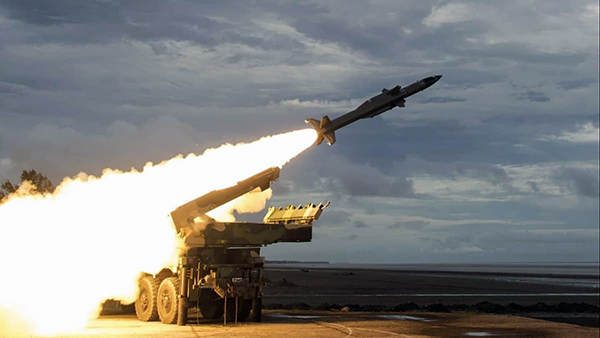Adding more firepower to India’s missile arsenal, Defence Research and Development Organisation (DRDO), on 27 September, successfully flight-tested a new version of the Akash missile from the integrated test range at Chandipur in Odisha. The missile -‘Akash Prime’ – intercepted and destroyed an unmanned aerial target mimicking an enemy aircraft in its maiden flight test.
The Akash Prime is a medium-range mobile surface-to-air missile (SAM) system developed by the DRDO and produced by Bharat Dynamics Limited (BDL).
The Akash SAM was developed to replace the Russian 2K12 Kub (SA-6 Gainful) missile system, currently in service. Like the Russian 2K12 Kub, it utilizes an integrated ramjet-rocket propulsion system, which, after initial rocket motor burnout, provides sustained thrust for the missile throughout its flight until interception.
In comparison to the existing Akash system, Akash Prime is equipped with an improved active radio-frequency (RF) seeker to further increase the accuracy. DRDO has also incorporated additions to make Akash Prime a more reliable performer under a low-temperature environment at higher altitudes.
The Indian Air Force has deployed Akash at its bases in Gwalior (Maharajpur AFS), Jalpaiguri (Hasimara AFS), Tezpur, Jorhat and Pune (Lohegaon AFS). Indian Army deployed Akash air defence system along Line of Actual Control in Ladakh as tension rose between India and China 2020 China–India skirmishes.
Earlier this year, DRDO tested the New Generation Akash Missile (Akash-NG). The missile was tested from a land-based platform with all weapon system elements.
Each battery of the Akash missile system consists of 4 launchers. Each launcher carries 3 missiles. Thus, there are always 12 missiles ready to be fired. Apart from these missiles each battery also carries loaders with extra missiles. The total number of missiles in each battery is 48. Each battery contains the main radar. This main radar is Rajendra Radar which is a 3D PESA radar. It provides command guidance to the missile. Each launcher is also equipped with its own fire control radar which works with the main radar and Battery Search Radar in a synchronized manner. All these systems are governed by Battery Command and Control Centre.
The Indian Air Force already operates 10 squadrons of Akash missile systems. Each squadron has two batteries and a total of 125 missiles each. The army has two operational regiments of the Akash system with 2000 missiles in total.
The first generation of Akash Prime missiles relied on the Rajendra Radars of their batteries for command guidance. That means that the missiles had no seeker of their own and were guided to the targets by the Rajendra radar throughout their trajectories. DRDO previously worked on Akash 1S variant with a radio frequency seeker for terminal guidance. Now, this Akash Prime variant is a further improved variant of the 1S variant. It is equipped with an improved indigenous RF seeker for terminal active radar homing. Previously the missile had a single-shot kill probability of 88%. Now with terminal guidance, it will increase even further making the missile deadlier.
The new system is optimized for low temperatures and higher altitudes. That means it is now more suitable to be deployed in Ladakh. All the components of the Akash systems can be mounted on BMP chassis if required. Thus, the system is highly mobile and can be deployed rapidly. In general, the components of the systems are mounted on BEML Tatra trucks.
Keeping China in mind this is a significant development as this system can be now deployed in harsh terrains like Ladakh. In 2020, there were reports that the Indian Army had deployed Akash SAMs in Ladakh during the standoff. But keeping the missiles battle-ready in such tough terrain is a difficult task. Moreover, Akash missiles are not packed in canisters which makes the maintenance even tougher.
Once inducted Akash Prime will be a crucial weapon for high altitude warfare. No additional infrastructure will be needed as it will be compatible with the current launchers and other components of its batteries. Akash Prime will play a crucial role in defending India’s airspace in future conflicts and standoffs in areas like Ladakh.


















